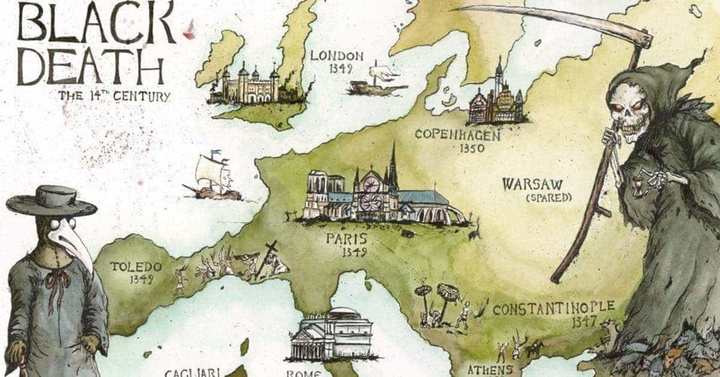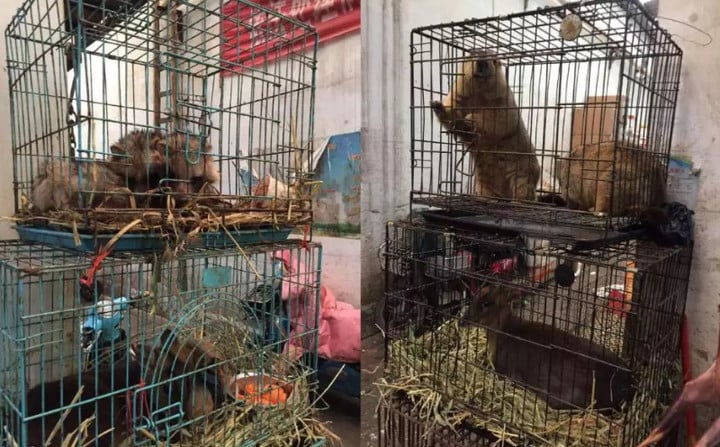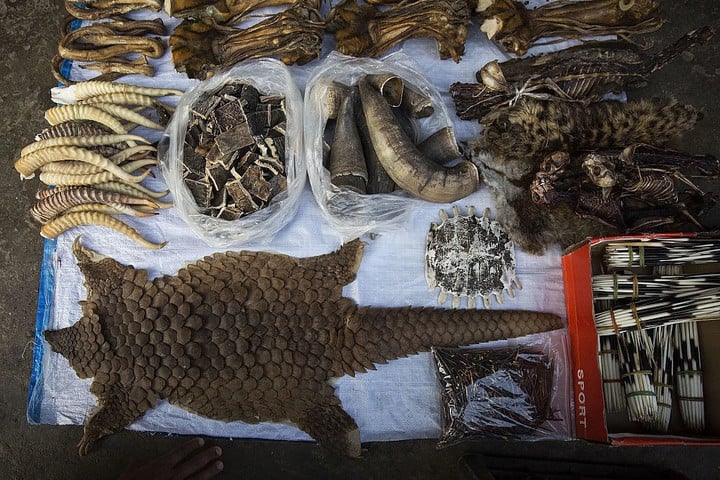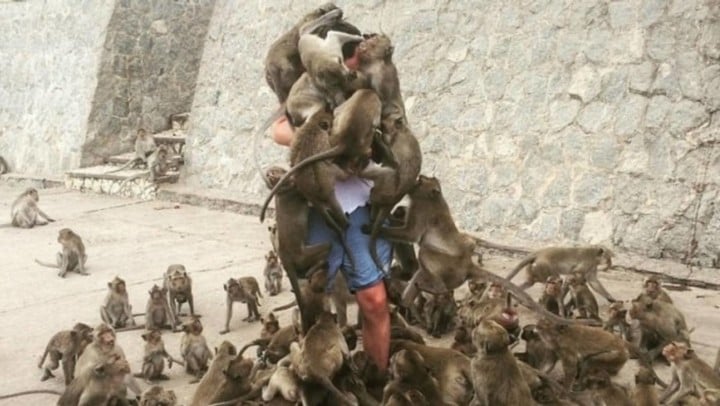In 1347, a port full of cargo sailed from the Black Sea in the Sicilian port of the Mediterranean Sea in Europe. This is the most anticipated moment for the port city.
But this time, in addition to the perfumes and dyes that can be exchanged for huge wealth, there was an unprecedented nightmare.
This nightmare has cost a third of the European population in just four years.
Extending the timeline, almost every major epidemic in human history is related to wildlife
Ring-a-round o roses (rose wreath)
A Pocket full of posies
Ashes Ashes
We all fall down
This is a nursery rhyme “RING AROUND THE ROSEY” that spread during the European Black Age (also known as the plague) in the Middle Ages. The “garland made of roses” is a metaphor for the dark red round herpes on the body; the “small bouquet full of pockets” implies that people must use aromatic flowers to cover up the smell of rotten flesh; “ash” means that people are burning the bodies.

The nursery rhymes are scary, but the disaster itself is even scarier.
This plague has claimed 25 million lives in Europe, accounting for more than a third of Europe’s population. Populations in some of the hardest-hit areas, such as Florence, are almost extinct.

Before modern times, people have been helpless with the Black Death, because people do not know the existence of pathogens.
It was not until 1984 that Yersin the French discovered the plague bacillus by dissecting the site of the dead body, and at the same time dug out the culprit.
That is the mouse that has coexisted with humans on this planet for two or three hundred years since the birth of humans. Later, the research team also thoroughly understood the transmission mechanism from mice to fleas to humans.

▲ Alexander Yersin
After clarifying the source of infection, and with modern times, the prevention and control of plague is much easier. Even if the plague is infected, it can be completely cured by timely treatment.
But plague has not been eradicated by humans like cholera.
Because they breed in large numbers on wild animals, especially the endless rodents, so far humans have only been able to coexist with them and always beware of a comeback.

▲ Yersinia pestis
Actually, apart from the Black Death, if the timeline is lengthened, almost every major epidemic in human history is related to wildlife.
For example, the Spanish pandemic that killed at least 40 million people in 1918 originated from birds; the Ebola virus, which has a fatality rate of 50% to 90%, was caused by the habit of eating jungle meat in Africa. Animals are moving towards humans; the two epidemic epidemics that have impressed the Chinese—atypical pneumonia and new crown pneumonia—are also caused by eating wild animals.
Research shows that worldwide, 78% of human-transmitted diseases originate from wild animals.

▲ Ebola virus moving to humans due to eating bush meat
These viruses do not appear suddenly. They often co-evolve with natural hosts for a long period of time, ranging from decades to hundreds of years, even tens of thousands of years.
But with the accelerated expansion of human activities and continuous penetration into the habitats of wild animals, these have greatly increased the contact between humans and animals, and created conditions for the virus to spread from wild animals to humans.
It ’s not just Chinese who like to eat game
The outbreak of new crown pneumonia, once again point the finger at those who eat game.
When did the Chinese people like to eat game?
The “Shen Nong’s Materia Medica” contains the earliest records of Chinese people eating wild animals, which also includes 67 kinds of animal medicine. So for nearly a thousand years, the Chinese habit of eating wild animals has continued to the present with Chinese medicine.

Reported by China News Weekly, the South China Seafood Market is just one part of the entire Wuhan game market, and there are many places in Wuhan where game is sold.
Wuhan is an important domestic market for game products, but such a market is not limited to Wuhan.
In December 2015, the Legal Working Committee of the Standing Committee of the National People’s Congress introduced that field investigations conducted in Hainan, Guangxi, Yunnan, Heilongjiang, Jilin, and Hubei found that illegal hunting, killing, and trading of wild animals in many places Places still exist to varying degrees. The habit of overeating and abusing wildlife is still quite prevalent in some areas. On the whole, China’s wildlife protection situation is still very grim.

Of course, eating the pot of wild animals cannot be carried only by the Chinese, because looking at the world, the habit of eating game is still quite common.
Europe and the United States like to eat elk, and even use it as a status symbol. Africans still retain the habit of eating jungle meat; Southeast Asia is even an integral part of the global wildlife smuggling chain.
Wildlife photographers shot a short film “The Mon” on wildlife products and illegal trade in a small town in Burma in 2007.g Lah Connection.
In this town, game restaurants can be found everywhere, and coupled with the government’s laissez-faire, tourists can easily find game that is hard to find in China, such as Chinese sturgeon, mule, and peacock.

▲ Illegal animal products sold on the streets of Myanmar, picture from: Nature World News
The Myanmar town is just a microcosm of the Southeast Asian wildlife market.
In a 2015 report from the London-based non-profit Environmental Investigation Agency, the Golden Triangle Special Economic Zone was publicly selling large numbers of protected animals.
In the early 1990s, the International Wildlife Trade Research Organization estimated that $ 160 billion worth of legal wildlife products were in circulation around the world. By 2009, that number had exceeded $ 323 billion. By 2009, that number had exceeded $ 323 billion.
It should be noted that these huge numbers represent only the part that is legally sold, and some studies have pointed out that the value of wildlife in illegal trade is even second only to drugs and arms.
The new crown virus is only one in 1.6 million, and even hugs will actually cause problems
Do n’t think that it ’s okay not to eat game food. In fact, it ’s easy to get sick if you touch wild animals.
Research shows that in 1940Seventy percent of human diseases detected between 2004 and 2004 are due to direct and indirect contact with wildlife.
When people are feeding or touching wild animals in scenic spots or suburbs, the virus fleas, mosquitoes, ticks, etc. on them spread to humans, and if they are scratched or bitten, the danger will be even higher. .
In the past, tourists used to play tuberculosis in Southeast Asia to develop tuberculosis; some tourists came into contact with wild monkeys and contracted rabies and monkeypox; and tourists caught deadly herpes due to the saliva of macaque monkeys splashing into their eyes. Virus B; and the cute and cute groundhog is also the host of Yersinia pestis.

Five new viruses appear every year worldwide, and the speed is increasing. And there are 1.6 million viruses unknown to humans in wildlife. Wildlife is a reservoir of virus in nature.
The struggle between modern medicine and pathogens is actually an endless arms race. The speed of people’s response to the outbreak has been greatly improved compared with the previous time. The speed of scientific institutions’ research on pathology and vaccines It is also accelerating.
But this is only a coping mechanism, it does not mean that we can isolate the disease well.

Shi Zhengli, a member of the SARS source tracking research team, said in his speech that it is actually very simple to prevent new infectious diseases from the source, that is, to stay away from wild animals.
She said that not only must we eliminate wildlife consumption and reduce intrusions on wildlife habitats, we humans must also stay away from wildlife.
Some people think that engaging in eco-tourism and intimate contact with wildlife is the harmony between man and nature, but this is not the case. The real harmonious coexistence is that you don’t disturb nature and let them live well.
After the outbreak of the new crown, Yuan Guoyong, a member of the high-level expert group of the National Health Commission also issued an appeal: “We must respect the lives of wild animals and the places where they live, because they are in the same global circle as us Residents here. “
During the Middle Ages, Europeans believed in theology and believed that the Black Death was a punishment from God to human beings, and even organized a parade to whipped themselves when the epidemic was out of control, hoping that God would see that human beings have realized their sins and thus let them pass .
Now that human beings are no longer superstitious, but can they really realize that the outbreak of epidemics is actually a warning from nature?
Picture from: “The Rise of Gorilla Ball”
Ring-a-round o roses (rose wreath)
A Pocket full of posies
Ashes Ashes
We all fall down
This is a nursery rhyme “RING AROUND THE ROSEY” that spread during the European Black Age (also known as the plague) in the Middle Ages. The “garland made of roses” is a metaphor for the dark red round herpes on the body; the “small bouquet full of pockets” implies that people must use aromatic flowers to cover up the smell of rotten flesh; “ash” means that people are burning the bodies.

The nursery rhymes are scary, but the disaster itself is even scarier.
This plague has claimed 25 million lives in Europe, accounting for more than a third of Europe’s population. Populations in some of the hardest-hit areas, such as Florence, are almost extinct.

Before modern times, people have been helpless with the Black Death, because people do not know the existence of pathogens.
It was not until 1984 that Yersin the French discovered the plague bacillus by dissecting the site of the dead body, and at the same time dug out the culprit.
That is the mouse that has coexisted with humans on this planet for two or three hundred years since the birth of humans. Later, the research team also thoroughly understood the transmission mechanism from mice to fleas to humans.

▲ Alexander Yersin
After clarifying the source of infection, and with modern times, the prevention and control of plague is much easier. Even if the plague is infected, it can be completely cured by timely treatment.
But plague has not been eradicated by humans like cholera.
Because they breed in large numbers on wild animals, especially the endless rodents, so far humans have only been able to coexist with them and always beware of a comeback.

▲ Yersinia pestis
Actually, apart from the Black Death, if the timeline is lengthened, almost every major epidemic in human history is related to wildlife.
For example, the Spanish pandemic that killed at least 40 million people in 1918 originated from birds; the Ebola virus, which has a fatality rate of 50% to 90%, was caused by the habit of eating jungle meat in Africa. Animals are moving towards humans; the two epidemic epidemics that have impressed the Chinese—atypical pneumonia and new crown pneumonia—are also caused by eating wild animals.
Research shows that worldwide, 78% of human-transmitted diseases originate from wild animals.

▲ Ebola virus moving to humans due to eating bush meat
These viruses do not appear suddenly. They often co-evolve with natural hosts for a long period of time, ranging from decades to hundreds of years, even tens of thousands of years.
But with the accelerated expansion of human activities and continuous penetration into the habitats of wild animals, these have greatly increased the contact between humans and animals, and created conditions for the virus to spread from wild animals to humans.
It ’s not just Chinese who like to eat game
The outbreak of new crown pneumonia, once again point the finger at those who eat game.
When did the Chinese people like to eat game?
The “Shen Nong’s Materia Medica” contains the earliest records of Chinese people eating wild animals, which also includes 67 kinds of animal medicine. So for nearly a thousand years, the Chinese habit of eating wild animals has continued to the present with Chinese medicine.

Reported by China News Weekly, the South China Seafood Market is just one part of the entire Wuhan game market, and there are many places in Wuhan where game is sold.
Wuhan is an important domestic market for game products, but such a market is not limited to Wuhan.
In December 2015, the Legal Working Committee of the Standing Committee of the National People’s Congress introduced that field investigations conducted in Hainan, Guangxi, Yunnan, Heilongjiang, Jilin, and Hubei found that illegal hunting, killing, and trading of wild animals in many places Places still exist to varying degrees. The habit of overeating and abusing wildlife is still quite prevalent in some areas. On the whole, China’s wildlife protection situation is still very grim.

Of course, eating the pot of wild animals cannot be carried only by the Chinese, because looking at the world, the habit of eating game is still quite common.
Europe and the United States like to eat elk, and even use it as a status symbol. Africans still retain the habit of eating jungle meat; Southeast Asia is even an integral part of the global wildlife smuggling chain.
Wildlife photographers shot a short film “The Mon” on wildlife products and illegal trade in a small town in Burma in 2007.g Lah Connection.
In this town, game restaurants can be found everywhere, and coupled with the government’s laissez-faire, tourists can easily find game that is hard to find in China, such as Chinese sturgeon, mule, and peacock.

▲ Illegal animal products sold on the streets of Myanmar, picture from: Nature World News
The Myanmar town is just a microcosm of the Southeast Asian wildlife market.
In a 2015 report from the London-based non-profit Environmental Investigation Agency, the Golden Triangle Special Economic Zone was publicly selling large numbers of protected animals.
In the early 1990s, the International Wildlife Trade Research Organization estimated that $ 160 billion worth of legal wildlife products were in circulation around the world. By 2009, that number had exceeded $ 323 billion. By 2009, that number had exceeded $ 323 billion.
It should be noted that these huge numbers represent only the part that is legally sold, and some studies have pointed out that the value of wildlife in illegal trade is even second only to drugs and arms.
The new crown virus is only one in 1.6 million, and even hugs will actually cause problems
Do n’t think that it ’s okay not to eat game food. In fact, it ’s easy to get sick if you touch wild animals.
Research shows that in 1940Seventy percent of human diseases detected between 2004 and 2004 are due to direct and indirect contact with wildlife.
When people are feeding or touching wild animals in scenic spots or suburbs, the virus fleas, mosquitoes, ticks, etc. on them spread to humans, and if they are scratched or bitten, the danger will be even higher. .
In the past, tourists used to play tuberculosis in Southeast Asia to develop tuberculosis; some tourists came into contact with wild monkeys and contracted rabies and monkeypox; and tourists caught deadly herpes due to the saliva of macaque monkeys splashing into their eyes. Virus B; and the cute and cute groundhog is also the host of Yersinia pestis.

Five new viruses appear every year worldwide, and the speed is increasing. And there are 1.6 million viruses unknown to humans in wildlife. Wildlife is a reservoir of virus in nature.
The struggle between modern medicine and pathogens is actually an endless arms race. The speed of people’s response to the outbreak has been greatly improved compared with the previous time. The speed of scientific institutions’ research on pathology and vaccines It is also accelerating.
But this is only a coping mechanism, it does not mean that we can isolate the disease well.

Shi Zhengli, a member of the SARS source tracking research team, said in his speech that it is actually very simple to prevent new infectious diseases from the source, that is, to stay away from wild animals.
She said that not only must we eliminate wildlife consumption and reduce intrusions on wildlife habitats, we humans must also stay away from wildlife.
Some people think that engaging in eco-tourism and intimate contact with wildlife is the harmony between man and nature, but this is not the case. The real harmonious coexistence is that you don’t disturb nature and let them live well.
After the outbreak of the new crown, Yuan Guoyong, a member of the high-level expert group of the National Health Commission also issued an appeal: “We must respect the lives of wild animals and the places where they live, because they are in the same global circle as us Residents here. “
During the Middle Ages, Europeans believed in theology and believed that the Black Death was a punishment from God to human beings, and even organized a parade to whipped themselves when the epidemic was out of control, hoping that God would see that human beings have realized their sins and thus let them pass .
Now that human beings are no longer superstitious, but can they really realize that the outbreak of epidemics is actually a warning from nature?
Picture from: “The Rise of Gorilla Ball”